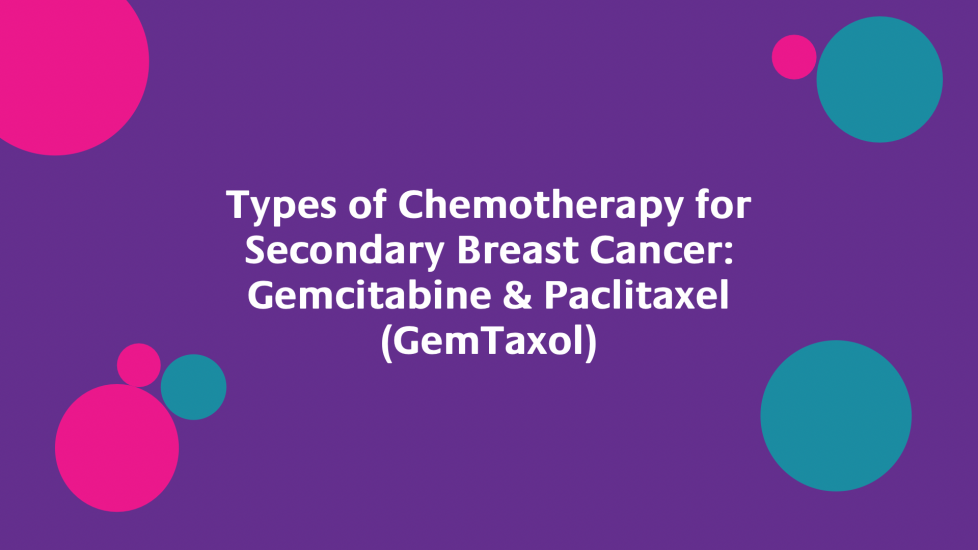30th January 2022 by Claire O'Donnell Education

Gemcitabine & Paclitaxel (GemTaxol)
GemTaxol is the name of a combination of chemotherapy drugs used to treat advanced breast cancer
It is made up of the drugs:
These chemotherapy drugs destroy quickly dividing cells, such as cancer cells.
How do you have GemTaxol?
You have both drugs into your bloodstream (intravenously).
You have the treatment through a drip into your arm or hand. A nurse puts a small tube (a cannula) into one of your veins and connects the drip to it.
You might need a central line. This is a long plastic tube that gives the drugs into a large vein, either in your chest or through a vein in your arm. It stays in while you’re having treatment.
When do you have GemTaxol?
You usually have GemTaxol chemotherapy as cycles of treatment. Each cycle of treatment lasts 21 days (3 weeks).
Example:
Day1:
You have gemcitabine as a drip into your bloodstream over 30 minutes.
You have paclitaxel as a drip into your bloodstream over 3 hours.
Day 2-7 :
You have no treatment.
Day 8:
You have gemcitabine as a drip into your bloodstream over 30 minutes.
Day 9-21:
You have no treatment.
Tests
You have blood tests before and during your treatment. They check your levels of blood cells and other substances in the blood. They also check how well your liver and kidneys are working.
Side effects
How often and how severe the side effects are can vary from person to person. They also depend on what other treatments you're having. For example, your side effects could be worse if you're also having other drugs or radiotherapy.
Common side effects
Increased risk of getting an infection
Increased risk of getting an infection is due to a drop in white blood cells. Symptoms include a change in temperature, aching muscles, headaches, feeling cold and shivery and generally unwell. You might have other symptoms depending on where the infection is.
Infections can sometimes be life threatening. You should contact your advice line urgently if you think you have an infection.
Breathlessness and looking pale
You might be breathless and look pale due to a drop in red blood cells. This is called anaemia.
Bruising and bleeding
This is due to a drop in the number of platelets in your blood. These blood cells help the blood to clot when we cut ourselves. You may have nosebleeds or bleeding gums after brushing your teeth. Or you may have lots of tiny red spots or bruises on your arms or legs (known as petechiae).
Tiredness and weakness (fatigue)
Tiredness and weakness (fatigue) can happen during and after treatment - doing gentle exercises each day can keep your energy up. Don't push yourself, rest when you start to feel tired and ask others for help.
Feeling or being sick
Feeling or being sick is usually well controlled with anti sickness medicines. Avoiding fatty or fried foods, eating small meals and snacks, drinking plenty of water, and relaxation techniques can all help.
It is important to take anti sickness medicines as prescribed even if you don’t feel sick. It is easier to prevent sickness rather than treating it once it has started.
Diarrhoea
Sore mouth
Mouth sores and ulcers can be painful. It helps to keep your mouth and teeth clean, drink plenty of fluids, avoid acidic foods such as oranges, lemons and grapefruits and chew gum to keep the mouth moist. Tell your doctor or nurse if you have ulcers.
Allergic reaction
A reaction may happen during the infusion, causing a skin rash, itching, swelling of the lips, face or throat, breathing difficulties, fever and chills. Your nurse will give you medicines beforehand to try to prevent a reaction.